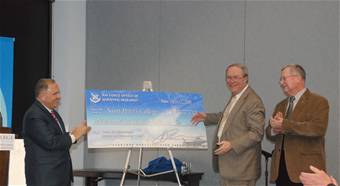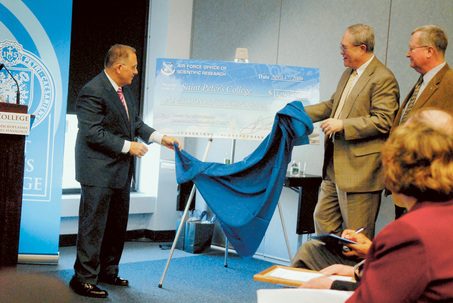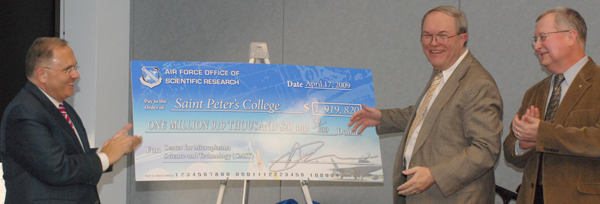
(L-R) Saint Peter’s College President Eugene J. Cornacchia, Ph.D. accepts a large novelty check from AFOSR Director Dr. Brendan Godfrey and AFOSR program manager, Dr. Robert Barker. The money will help fund the formal establishment of the College’s Center for Microplasma Science and Technology. (Credit: Saint Peter’s College, Jersey City, N.J.)
ARLINGTON, VA. — On Friday, April 17, 2009, Air Force Office of Scientific Research (AFOSR) leadership traveled to Jersey City, N.J. to help celebrate the establishment of the St. Peter’s College (SPC) Center for Microplasma Science and Technology (CMST).
As part of the event hosted by SPC President Eugene J. Cornacchia, Ph.D., AFOSR Director Dr. Brendan B. Godfrey presented a large check to the Department of Applied Science and Technology to help establish the new center. The physical size of the $1,919,820 AFOSR grant check symbolized both AFOSR’s financial support and its enthusiasm toward the CMST.
“This new center promises to serve as a unifying focus and resource for the microplasma research community combining first-class, in-house research with excellent visiting scientist opportunities, broad student involvement, and even international workshops,” said Godfrey.
He also shared AFOSR’s enthusiasm about the outreach this new center is planning for the minority student community. “The science and engineering fields need to draw upon a broader talent base — one that encompasses our entire society,” he said.
The new CMST at Saint Peter’s College will serve as the nation’s first and only scientific and educational center devoted entirely to the emerging field of microplasma research in the United States.
The establishment of this unique center means a great deal to AFOSR, as the basic research performed here addresses a number of key Air Force requirements in areas as diverse as hypersonic actuators and pulsed power switching.
By sponsoring such programs, AFOSR continues to expand the horizon of scientific knowledge through its leadership and management of the Air Force’s basic research program.
The Air Force Office of Scientific Research (AFOSR) news article link – https://www.wpafb.af.mil/news/story.asp?id=123145516
]]>The NTDTV news report documents the CMST ceremony where Dr. Brendan B. Godfrey, Director of the Department of Defense’s Air Force Office of Scientific Research (AFOSR) and Dr. Robert J. Barker, Program Manager of Electro-Energetic Physics for AFOSR presented a ceremonial $2 million check to SPC. The news report includes an interview with Mayor of Jersey City, Jerramiah T. Healy and CMST’s Director of Research, WeiDong Zhu.
NTDTV provides a wide range of programs in Mandarin, Cantonese, and English. The 24/7 programming ranges from primetime drama series, cultural shows, educational programs, and children’s shows, to sports and entertainment, finance and business programs, lively talk shows, and many original programs on other topics of interest to Chinese people everywhere. The station’s flagship program is news, which provides timely reporting nine times a day on important events from around the world. A significant portion of these programs focuses on traditional Chinese culture and current affairs in Asia.
The link to see the NTDTV news report – https://www.ntdtv.com/xtr/b5/2009/04/18/a283115.html/#video
]]>
Saint Peter’s College President Eugene Cornacchia, left, and Dr. Brenden Godfrey of the Air Force Office of Scientific Research, unveil a check for more than $1.9 million. The money will help fund the formal establishment of the College’s Center for Microplasma Science and Technology. (Photo by Dylan Wilson, The Jersey Journal)
Jersey City, N.J. – It may not be easy to define microplasma, but officials from Saint Peter’s College and the U.S. Department of Defense surely had no problem explaining the benefits of the $2 million awarded to the school to establish the Center for Microplasma Science and Technology Friday at the Jersey City college.
Microsplasma is a recent phenomena and its uses — such as creating large quantities of ozone — are still being explored. The physical, electrical and optical properties have also been applied to technologies such as water purification.
“An exciting new era in science and technology has dawned at Saint Peter’s College,” college President Eugene J. Cornacchia said. “We are so excited and grateful the federal government has chosen to invest in the sciences at Saint Peter’s.”
Research conducted at the Center for Microplasma Science and Technology (CMST) — the first scientific and educational center in the nation devoted to the emerging field — is expected to help the Department of Defense refine their use of microplasmas for defense-related projects.
Officials also said microplasma technology would aid in aerospace research.
“Through the Center, the College will be able to enrich and expand course offerings and enhance student opportunities for research internships,” said Marylou Yam, Vice President for Academic Affairs at the College. “Our students will be exposed to national and international research in the area, and will work with faculty and professional scientists on cutting edge research on microplasmas. We look forward to the exciting future that it promises.”
The CMST at Saint Peter’s College is expected to become a hub for all laboratories across the country currently studying microplasmas; and will organize research efforts and host scientific meetings, workshops and conferences.
“I think it’s particularly appropriate that the Center will be part of your new Department of Applied Science and Technology because the applications that will flow will have a great impact not only academically and for the Department of Defense, but for businesses in New Jersey and elsewhere,” said Brendan B. Godfrey, director of the Department of Defense’s Air Force Office of Scientific Research (AFOSR).
The Jersey Journal article link – https://www.nj.com/hudson/index.ssf/2009/04/2_million_awarded_to_saint_pet.html
]]>
Saint Peter’s College President Eugene Cornacchia, left, is presented a check by Director of the Air Force Office of Scientific Research (AFOSR) Dr. Brenden Godfrey, middle, and AFOSR’s Program Manager of Electro-Energetic Physics Dr. Robert J. Barker, right, on Friday, April 17, 2009.
Jersey City, N.J. – On Friday, April 17, 2009, President of Saint Peter’s College Eugene J. Cornacchia, Ph.D., joined Mayor of Jersey City Jerramiah T. Healy to welcome representatives from the U.S. Department of Defense for the formal establishment of the College’s Center for Microplasma Science and Technology (CMST).
“Locating the CMST within a higher education context stimulates educational outreach to young researchers pursuing careers in sciences,” said President Cornacchia. Mayor Healy, who presented a proclamation for the CMST, also noted, “The education of our youth in the areas of science and math are critical during this technological era and will allow for us to best compete with countries in Europe and Asia. We are pleased that this vital educational tool is being brought to Saint Peter’s College and to Jersey City, placing this renowned institution at the forefront of the microplasma field.”
The day’s events included remarks given by Marylou Yam, Ph.D, the College’s vice president for academic affairs, in addition to Dr. Brendan B. Godfrey, director of the Department of Defense’s Air Force Office of Scientific Research (AFOSR). Dr. Robert J. Barker, program manager of Electro-Energetic Physics for AFOSR, joined Dr. Godfrey to present the $2 million check for the CMST.
Dr. Godfrey guides the management of the entire basic research investment for the U.S. Air Force, leading a staff of 200 scientists, engineers and administrators in Arlington, Virginia and foreign technology offices in London and Tokyo. Dr. Barker is an internationally recognized expert in the fields of plasma physics, microwave generation, and computational physics.
Len Sciorra, Ph.D., chair of the College’s Department of Applied Science and Technology, as well as Jose Lopez, Ph.D., and Wei-Dong Zhu, Ph.D., Assistant Professors of Physics for Saint Peter’s, provided closing remarks, which was followed by a question and answer session.
Saint Peter’s Department of Applied Science and Technology was awarded the $2 million in federal funding from the United States Department of Defense to establish the CMST in October 2008. The CMST, which is also a designated National Center of Excellence, will serve as the nation’s first and only scientific and educational center devoted entirely to the emerging field of microplasma research in the United States.
The purpose of establishing the CMST at Saint Peter’s is to create a hub for all laboratories across the country currently studying microplasmas, organize their research efforts, and host scientific meetings, workshops and conferences to help the national scientific research effort move forward.
]]>Funded by a $450,000 private grant, the PARSE Institute represents a cooperative effort between Saint Peter’s Applied Science and Technology and Education departments, and in collaboration with the Center for Microplasma Science & Technology (CMST), Princeton Plasma Physics Laboratory (PPPL), and Liberty Science Center (LSC).
The PARSE Institute offers science teachers in Hudson County the opportunity to perform scientific research and incorporate experimental findings into their curriculum. The program strives to create a larger, more highly skilled and highly educated scientific and technological workforce.
“The depth of service and breadth of contact distinguishes PARSE from other professional development opportunities,” noted Dr. Jose L. Lopez, Director of the Scientific Program for the PARSE Institute. “It is a resource that will help science and technology teachers better educate their students, and encourage them to pursue careers in science and technology.”
In the July 2009 pilot program, a group of teachers will participate in an orientation that consists of an introduction to the PARSE Institute’s partners and research projects, educational theory workshops, site visits and a survey of modern scientific advancement.
Following orientation, the teachers will perform two to three weeks of hands-on research with a professional scientist in the teachers’ choice of concentration: plasma physics, energy, the environment, or biotechnology and human genetics. After completing the research, participants and Saint Peter’s faculty will collaborate to translate the research experiences into discernible curricular units. At that time, they will also address the New Jersey Core Curriculum Standards in Science.
Upon completion of the program, teachers will be considered PARSE Fellows. In addition to their intensive practical research experience, individuals will receive continuous mentor support and have the opportunity to participate in classroom visits or observations, field trips and additional research opportunities. Smaller and shorter programs will also be offered throughout the course of the academic year.
For more details regarding the program, please visit www.spc.edu/parse, or contact Dr. Lopez at [email protected], or Dr. James J. Clayton, Director of the Educational Program for the PARSE Institute at [email protected].
]]>